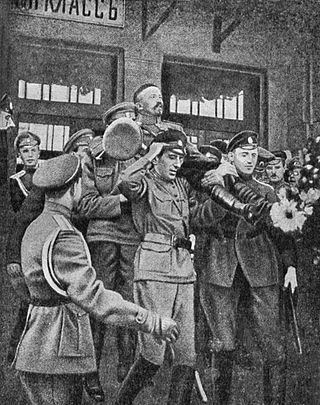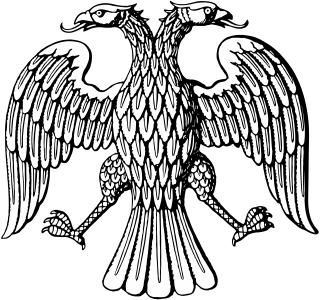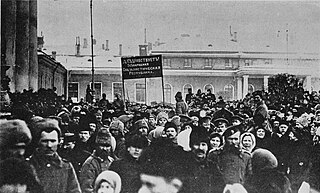
Alexander Fyodorovich Kerensky was a Russian lawyer and revolutionary who led the Russian Provisional Government and the short-lived Russian Republic for three months from late July to early November 1917 (N.S.).

Lavr Georgiyevich Kornilov was a Russian military intelligence officer, explorer, and general in the Imperial Russian Army during World War I. He served as Supreme Commander of the Russian Army and as the military leader of the Whites in the Russian Civil War. He is particularly remembered for the Kornilov affair, an unsuccessful coup d’etat against the Provisional Government led by Alexander Kerensky. The event became a significant turning point in the Russian Revolution, strengthening the Bolsheviks' position and influence.

The October Revolution, also known as the Great October Socialist Revolution, October coup, Bolshevik coup, or Bolshevik revolution, was the second of two revolutions in Russia in 1917. It was led by Vladimir Lenin's Bolsheviks as part of the broader Russian Revolution of 1917–1923. It began through an insurrection in Petrograd on 7 November 1917 [O.S. 25 October]. It was the precipitating event of the Russian Civil War. The initial stage of the October Revolution, which involved the assault on Petrograd, occurred largely without any casualties.

The Kornilov affair, or the Kornilov putsch, was an attempted military coup d'état by the commander-in-chief of the Russian Army, General Lavr Kornilov, from 10 to 13 September 1917, against the Russian Provisional Government headed by Aleksander Kerensky and the Petrograd Soviet of Soldiers' and Workers' Deputies. The exact details and motivations of the Kornilov affair are unconfirmed due to the general confusion of all parties involved. Many historians have had to piece together varied historical accounts as a result.

María Leontievna Bochkareva was a Russian soldier who fought in World War I and formed the Women's Battalion. She was the first Russian woman to command a military unit.
The Kerensky–Krasnov uprising was an attempt by Alexander Kerensky to crush the October Revolution and regain power after the Bolsheviks overthrew his government in Petrograd. It took place between 8 and 13 November 1917 [O.S. 26 and 31 October].

The Allied intervention in the Russian Civil War consisted of a series of multi-national military expeditions that began in 1918. The initial impetus behind the interventions was to secure munitions and supply depots from falling into the German Empire's hands, particularly after the Bolsheviks signed the Treaty of Brest-Litovsk, and to rescue the Allied forces that had become trapped within Russia after the 1917 October Revolution. After the Armistice of 11 November 1918, the Allied plan changed to helping the White forces in the Russian Civil War. After the Whites collapsed, the Allies withdrew their forces from Russia by 1925.
The Executive Committee of the Petrograd Soviet, commonly known as the Petrograd Soviet Ispolkom was a self-appointed executive committee of the Petrograd Soviet. As an antagonist of the Russian Provisional Government, after the 1917 February Revolution in Russia, the Ispolkom became a second center of power. It was dissolved during the Bolshevik October Revolution later that year.

The July Days were a period of unrest in Petrograd, Russia, between 16–20 July [O.S. 3–7 July] 1917. It was characterised by spontaneous armed demonstrations by soldiers, sailors, and industrial workers engaged against the Russian Provisional Government. The demonstrations were angrier and more violent than those during the February Revolution months earlier.

The Kerensky offensive, also called the summer offensive, the June offensive in Russia, or the July offensive in Western historiography, took place from 1 July [O.S. 18 June] to 19 July [O.S. 6 July] 1917 and was the last Russian offensive of World War I. After the abdication of Emperor Nicholas II during the February Revolution, the Russian Provisional Government pledged to fulfill Russia's existing commitments to the Triple Entente, which included launching an offensive in the spring of 1917. The operation was directed at capturing Lemberg and the rest of Galicia from Austria-Hungary.

Mikhail Artemyevich Muravyov was a Russian officer who changed sides during the time of the Civil War in Russia and the Soviet-Ukrainian war.
The Russian Revolutions of 1917 saw the collapse of the Russian Empire, a short-lived provisional government, and the creation of the world's first socialist state under the Bolsheviks. They made explicit commitments to promote the equality of men and women. Many early Russian feminists and ordinary Russian working women actively participated in the Revolution, and all were affected by the events of that period and the new policies of the Soviet Union.

The Red Cossacks was a military formation of Bolsheviks and the Soviet government of Ukraine. Red Cossacks was a collective name for one of the biggest cavalry formations of the Workers' and Peasants' Red Army (RKKA) and was part of the Ukrainian, Southern, and Southwestern fronts during the Russian Civil War and later was stationed in the Ukrainian SSR.

The Russian Provisional Government was a provisional government of the Russian Empire and Russian Republic, announced two days before and established immediately after the abdication of Nicholas II on 2 March, O.S. [15 March 1917, N.S.], during the February Revolution. The intention of the provisional government was the organization of elections to the Russian Constituent Assembly and its convention. The provisional government, led first by Prince Georgy Lvov and then by Alexander Kerensky, lasted approximately eight months, and ceased to exist when the Bolsheviks gained power in the October Revolution in October [November, N.S.] 1917.

The Riga offensive, also called the Jugla Offensive or the Battle of Riga, took place in early September 1917 and was the last major campaign on the Eastern Front of World War I before the Russian Provisional Government and its army began disintegrating.

The February Revolution, known in Soviet historiography as the February Bourgeois Democratic Revolution and sometimes as the March Revolution or February Coup was the first of two revolutions which took place in Russia in 1917.

In March [O.S. February] 1917, the Russian Army ceased to be the Imperial Russian Army when Emperor Nicholas II abdicated and the Provisional Government became the governing authority. It was officially a caretaker government until September 1917, when the Russian Republic was proclaimed. The army started to be referred to as the Revolutionary Army of Free Russia by the Provisional Government.

The Stavka of the Supreme Commander was the supreme headquarters of the Russian Imperial Army in the field during World War I until the demobilization of the army in March 1918.
The Establishment of Soviet power in Russia was the process of establishing Soviet power throughout the territory of the former Russian Empire, with the exception of areas occupied by the troops of the Central Powers, following the seizure of power by Bolsheviks in Petrograd on 7 November 1917 [O.S. 25 October], and in mostly completed by the beginning of the German offensive along the entire front on February 18, 1918.

The Kornilov Shock Regiment, previously the 1st Shock Detachment and also called Kornilovites (корниловцы), was a shock unit of the Russian Army founded during World War I that later was part of the Volunteer Army during the Russian Civil War. It became the last regiment of the Russian Army to be formed and the first regiment of the Volunteer Army.
















